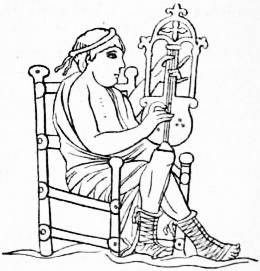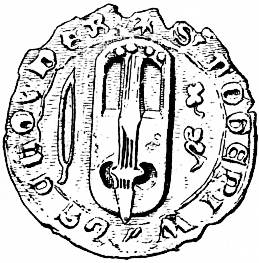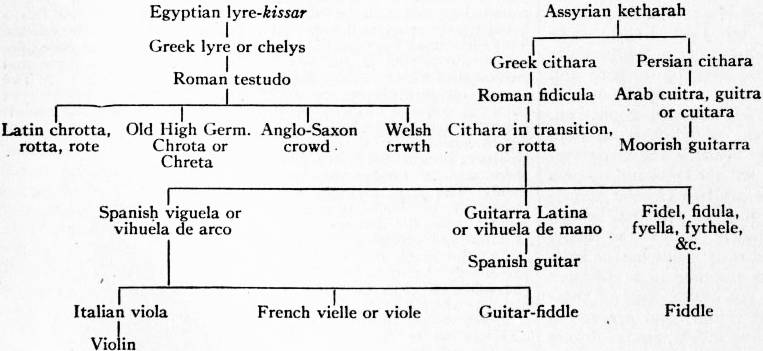Crowd, Crouth, Crowth (Welsh crwth; Fr. crout; Ger. Chrotta, Hrotta), a medieval stringed instrument derived from the lyre, characterized by a sound-chest having a vaulted back and an open space left at each side of the strings to allow the hand to pass through in order to stop the strings on the finger-board. The Welsh crwth, which survived until the end of the 18th century, is best represented by a specimen of that date preserved in the Victoria and Albert Museum, and described and illustrated by Carl Engel.1 The instrument consists of a rectangular sound-chest 22 in. long, 9½ in. wide and 2 in. deep; the body is scooped out of a single block, the flat belly being glued on. Right through the sound-chest on each side of the finger-board is the characteristic open space left for the hand to pass through. There are two circular sound-holes; the left foot of the flat bridge, which lies obliquely across the belly, passes through the left sound-hole and rests inside on the back of the instrument. Six catgut strings fastened to a tail-piece are wound round pegs at the top of the crwth; four of these strings lie over the sound-board and bridge, and are set in vibration by means of a bow, while the two others, used as drones and stretched across the left-hand aperture, are twanged by the thumb of the left hand. The shape and shallowness of the bridge make it impossible to sound a single string with the bow; the arrangement of the strings suggests that they were intended to be sounded in pairs. The instrument is tuned thus: 
At the beginning of the 19th century, William Bingley2 heard a Welsh peasant playing national airs on a crwth strung as follows:— . Sir John Hawkins3 relates that in his time there was still a Welshman living in Anglesea who understood how to play the crwth according to traditional usage. Edward Jones4 and Daines Barrington5 both give an account of the Welsh crwth of the 18th century which agrees substantially with Engel’s; the illustration communicated by Daines Barrington shows the strings of the crwth drawn through holes at the top, and fastened on the back, as on the Persian rebab and other Oriental stringed instruments. On these somewhat scanty authentic records of the instrument, several historians of music have based an illogical claim that the crwth, or rather chrotta or rotta, mentioned by Venantius Fortunatus as a British instrument, was the Welsh crwth as it was known in the 18th century, and was the earliest bowed instrument, and therefore the ancestor of the violin. The lines of Fortunatus, who was bishop of Poictiers during the second half of the 6th century, ran thus:—6
. Sir John Hawkins3 relates that in his time there was still a Welshman living in Anglesea who understood how to play the crwth according to traditional usage. Edward Jones4 and Daines Barrington5 both give an account of the Welsh crwth of the 18th century which agrees substantially with Engel’s; the illustration communicated by Daines Barrington shows the strings of the crwth drawn through holes at the top, and fastened on the back, as on the Persian rebab and other Oriental stringed instruments. On these somewhat scanty authentic records of the instrument, several historians of music have based an illogical claim that the crwth, or rather chrotta or rotta, mentioned by Venantius Fortunatus as a British instrument, was the Welsh crwth as it was known in the 18th century, and was the earliest bowed instrument, and therefore the ancestor of the violin. The lines of Fortunatus, who was bishop of Poictiers during the second half of the 6th century, ran thus:—6
|
“Romanusque lyra, plaudat tibi Barbarus harpa, Graecus Achilliaca, chrotta Britanna canat.” |
The bow is not mentioned by Fortunatus, and there is no ground whatever for believing that the Welsh crwth was played with a bow in the 6th century, or indeed for several centuries after. The stringing of the Welsh crwth with the two drone strings still twanged, the form of the body without incurvations, the flat bridge which rendered bowing, even in the most highly developed specimens of the 18th century, a difficult task, together with what is known of the early history of the chrotta and rotta derived from the lyre and cithara and like them twanged by fingers or plectrum, all make the claim untenable. Carl Engel was probably the first to expose the fallacy in his work on the violin.7
 |
| Drawn from a plate in Auguste de Bastard’s Peintures et ornements de la bible de Charles le Chauve. |
| Fig. 2.—Early Crwth, 9th century. |
British lexicographers all agree in deriving the words crwth, crowd and other forms of the name, from some word meaning a bulging protuberant bellying form, while in German the etymology of the word Chrotta is given as Chrota or Chreta, the O.H.G. for Kröte = toad, Schildkröte = tortoise. This word Chrotta was undoubtedly the German equivalent term for the lyre of Hermes, having as back a tortoise-shell, χέλυς in Greek and testudo in Latin. Chrotta was also spelt hrotta, and it is easy to see how this became rotta. A thoughtful and suggestive treatment of the whole subject will be found in Engel’s work, to which reference has been made. Just as the lyre and cithara, which appeared to be similar to the casual observer, and are indeed still confused at the present day, were instruments differing essentially in construction8; so there were, during the early middle ages, while lyre and cithara were still in transition, two types of chrotta or rotta. (1) The rotta or improved cithara had a body either rectangular with the corners rounded, or guitar-shaped with incurvations, back and sound-board being nearly or quite flat, joined as in the cithara by ribs or sides. This rotta must be reckoned among the early ancestors of the violin before the advent of the bow; it was known both as rotta and cithara, and with a neck added it became the guitar-fiddle. (2) The tortoise or lyre chrotta consisted of a protuberant, very convex back cut out of a block of wood, to which was glued a flat sound-board, at first like the lyre, without intermediary ribs. This instrument became the crwth, and there was no further development. The first step in the transition of both lyre and cithara was the incorporation of arms and cross-bar into the body, the same outline being preserved; the second step was the addition of a finger-board against which the strings were stopped, thus increasing the compass while restricting the number of strings to three or four; the third step, observed only in the rotta-cithara, consisted in the addition of a neck,9 as in the guitar. The crwth, crowd, crouth did not undergo this third transition even when the bow was used to set the strings in vibration.
 |
| Fig. 3.—Crowd on a 14th-century Seal. |
The earliest representation of the crwth yet discovered dates from the Carolingian period. In the miniatures of the Bible of Charles the Bald,10 in the Bibliothèque Nationale, Paris, one of the musicians of King David is seen stopping strings on the finger-board with his left hand and plucking them with the right (fig. 2); this crwth has only three strings, and may be the crwth trîthant of Wales. A second example occurs in the Bible of St Paul,11 another of the magnificent MSS. prepared for Charles the Bald, and preserved during the middle ages in the monastery of St Paul extra muros in Rome (now deposited in that of St Calixtus in Rome). Other representations are in the miniatures of the 11th, 12th and 13th centuries. To Edward Heron-Allen (De fidiculis opuscula, viii., 1895) is due the discovery of a representation of the Welsh crwth, showing the form still retained in the 18th cent. On the seal of Roger Wade (1316) is a crwth differing but little from the specimen in the Victoria and Albert Museum. The 14th-century instrument had four strings instead of six, and the foot of the bridge does not appear to pass through the sound-hole—a detail which may have escaped the notice of the artist who cut the seal. The original seal lies in the muniment room at Berkeley Castle in Gloucestershire attached to a defeasance of a bond between the crowder and his debtor Warren de l’Isle, and a cast (see fig. 3) is preserved at the British Museum. The British Museum also possesses two interesting MSS. which concern the crwth: one of these (Add. MS. 14939 ff. 4 and 27) contains an extract made by Lewis Morris in 1742 from an ancient Welsh MS. of “Instructions supposed to be wrote for the Crowd”; the other (Add. MS. 15036 ff. 65b and 66) consists of tracings from a 16th-century Welsh MS. copied in 1610 of a bagpipe, a harp and a krythe, together with the names of those who played the last at the Eisteddfod. The drawing is crude, and shows an instrument similar to Roger Wade’s crowd, but having three strings instead of four.
The genealogical tree of the violin given below shows the relative positions of both kinds of rotta and chrotta.

The Welsh crwth was therefore obviously not an exclusively Welsh instrument, but only a late 18th-century survival in Wales of an archaic instrument once generally popular in Europe but long obsolete. An interesting article on the subject in German by J. F. W. Wewertem will be found in Monatshefte für Musik (Berlin, 1881), Nos. 7-12, p. 151, &c.
1 See Early History of the Violin Family (London, 1883), pp. 24-36.
2 See A Tour round North Wales (London, 1804), vol. ii. p. 332.
3 History of Music (London, 1766), vol. ii. bk. iii. ch. iii., description and illustration.
4 Musical and Poetical Relicks of Welsh Bards (London, 1794), illustration of crwth, also reproduced by Carl Engel; see note above.
5 Archaeologia, vol. iii. (London, 1775).
6 Venantius Fortunatus, Poëmata, lib. vii. cap. 8, p. 245; see Migne’s Patrologia Sacra, vol. 88.
7 Op. cit. chapters “Crwth,” “Chrotta,” “Rotta.”
8 See Kathleen Schlesinger, Orchestral Instruments, part ii., “The Precursors of the Violin Family” (London, 1909), pp. 14 to 23, with illustrations.
9 See also Kathleen Schlesinger, op. cit. ch. vii., “The Cithara in Transition,” pp. 111-135 with illustrations.
10 See Auguste de Bastard, Peintures et ornements des MSS. de France, and Peintures, ornements, &c., de la bible de Charles le Chauve, in facsimile (Paris, 1883).
11 See J. O. Westwood, Photographic Facsimile of the Bible of St Paul (London, 1876).


